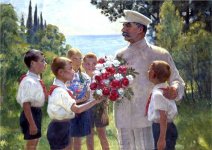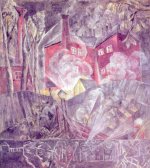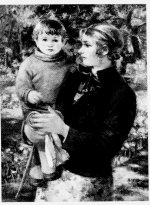lushd
Donald
December marks the 50th anniversary of the death of Alexandr Rodchenko. Judging by many of the pictures in the gallery, we all owe him quite a debt:
http://www.2x36.ru/articles/rodchenko/rodchenko_protiv.html
http://en.wikipedia.org/wiki/Alexandr_Rodchenko
Rodchenko was well known for using a Leica.
http://www.2x36.ru/articles/rodchenko/rodchenko_protiv.html
http://en.wikipedia.org/wiki/Alexandr_Rodchenko
Rodchenko was well known for using a Leica.
Nachkebia
Well-known
He used Leica? strange, in a red soviet... very strange, anyhow when I stated with photography I was around 18 years old and my favorite photographer was Alexander Rodchenko! I still admire him!
lushd
Donald
When he was at his creative photographic peak in the 20's neither FEDs nor Zorkis were available.Nachkebia said:He used Leica? strange, in a red soviet... very strange, anyhow when I stated with photography I was around 18 years old and my favorite photographer was Alexander Rodchenko! I still admire him!
Nachkebia
Well-known
Ah, You obviously know more 
Joao
Negativistic forever
Hello
Yes, he started with plate-cameras and switched to Leica in 1928. He used a Leica in his photos – and also as a subject, as in this famous photo.
http://rodchenko.notlong.com
Regards
Joao
RF: Zork(1, 4), Fed(5, 2), Sokol (Automat, 2), Junost, Iskra, Kiev-4,
TLR: Komsomolyets, Lubitel (2, 166B), Flexaret
SLR: Zenit (3M, E, EM, ET, TTL, 12XP, 122K,19, Photosniper), Kiev-10, Olympus OM-2
Other: FED-50, Kiev35A, Smena (7, 8M), Estafeta
Yes, he started with plate-cameras and switched to Leica in 1928. He used a Leica in his photos – and also as a subject, as in this famous photo.
http://rodchenko.notlong.com
Regards
Joao
RF: Zork(1, 4), Fed(5, 2), Sokol (Automat, 2), Junost, Iskra, Kiev-4,
TLR: Komsomolyets, Lubitel (2, 166B), Flexaret
SLR: Zenit (3M, E, EM, ET, TTL, 12XP, 122K,19, Photosniper), Kiev-10, Olympus OM-2
Other: FED-50, Kiev35A, Smena (7, 8M), Estafeta
reagan
hey, they're only Zorkis
I liked this photo of Rodchenko I saw in Oscar Fricke's article on The Dzerzhinsky Commune.

See? It is important to hold your mouth juuuuuust right.

See? It is important to hold your mouth juuuuuust right.
Nachkebia
Well-known
Oh right eyeders, scare everyone who looks at them, here is one reason why left eyers are cooler 
lubitel
Well-known
the essay is very strange. Here is an excerpt which i cruedly translated.
"There is no place for art in modern life. It still exists, because there is a romantic minority and people live with beautiful lies. To fight against art as opium is a must for every cultural person. Dont lie! Take photographs and be photographed! Dont freeze a person with one "synthetic" portrait, but with numerous moment-photos, taken in different times with different conditions. Write the truth. Prize everything that is real and modern. And we will be real people and not toys."
"There is no place for art in modern life. It still exists, because there is a romantic minority and people live with beautiful lies. To fight against art as opium is a must for every cultural person. Dont lie! Take photographs and be photographed! Dont freeze a person with one "synthetic" portrait, but with numerous moment-photos, taken in different times with different conditions. Write the truth. Prize everything that is real and modern. And we will be real people and not toys."
reagan
hey, they're only Zorkis
I think we caught Alek shooting with both eyes closed. hmmmm. I should try that.Nachkebia said:Oh right eyeders, scare everyone who looks at them, here is one reason why left eyers are cooler
Jocko
Off With The Pixies
lubitel said:the essay is very strange. Here is an excerpt which i cruedly translated.
"There is no place for art in modern life. It still exists, because there is a romantic minority and people live with beautiful lies. To fight against art as opium is a must for every cultural person. Dont lie! Take photographs and be photographed! Dont freeze a person with one "synthetic" portrait, but with numerous moment-photos, taken in different times with different conditions. Write the truth. Prize everything that is real and modern. And we will be real people and not toys."
Such comments seemed far less strange in the early 20th century - although Rodchenko was arguably behind the times in voicing them as late as he did. Early 20th century Russian art was profoundly influenced by Symbolism, a movement to some extent obscured by western art historians in favour of the ever-popular Impressionist pretty-pretty.
Symbolism was rooted in philosophical Idealism - the idea that consciousness dictates reality. As such it formed the source for Futurism (and its British variant, Vorticism), which embraced the liberating confusion and violence of technology, replacing the romantic concept of the individual with the exhilarating chaos of the mass and the machine. The sedative illusion of art - the static paintings of pretty girls with parasols in cornfields - were to be replaced by the ecstatic liberation of destructive, transformative power. This process was directly identified with war and revolution; with a Marxist or Social-Darwinist struggle to impose the will of the artist on the nature of life itself, to embrace and ride the current of the chaotic new reality. The artist was thus the enemy of art, defined as the expression of a dead world.
Italian Fascism effectively began as the political wing of the Futurist movement. Likewise, most Russian Symbolists and Futurists eagerly rallied to Bolshevism. Whilst sections within the Italian regime remained loyal to Futurist ideals, the Soviets did not, swiftly embracing a comfortably bourgeois form of genre art with Symbolist elements - "Socialist Realism" - reflecting the supposed eternity and solidity of the USSR. Rodchenko got into considerable trouble for retaining his Futurist convictions under Stalin.
Cheers, Ian
Last edited:
netzspannung
aka _basil
Ian, it is so nice to meet someone knowledgeable of the subject. A bit schematic, but close to the truth  hello from Russia
hello from Russia
http://www.photographer.ru/galleries/show.htm?id=37&pic=1
http://www.photographer.ru/galleries/show.htm?id=37&pic=1
lushd
Donald
As always, Ian is spot on. The (romantic) ideal that art will destroy corruption and make the world over on more rational and just lines surfaces often in European culture over the last two centuries.
While the Soviet Union went it's way, in the west manifestations such as Cubism, Dada and Surrealism were also very influential as well as the movements mentioned by Ian, although as in the USSR they ran out of steam quickly. Nothing as vigorous or influential has taken their places. Since WW2 and I think we are are a bit rudderless.
While the Soviet Union went it's way, in the west manifestations such as Cubism, Dada and Surrealism were also very influential as well as the movements mentioned by Ian, although as in the USSR they ran out of steam quickly. Nothing as vigorous or influential has taken their places. Since WW2 and I think we are are a bit rudderless.
lubitel
Well-known
Ian thanks for the interesting reply,
but doesnt he contradict himself with photos like this?
http://www.photographer.ru/galleries/show.htm?id=37&pic=21
Isn't that exactly what he describes as "opium art" or romantic?
but doesnt he contradict himself with photos like this?
http://www.photographer.ru/galleries/show.htm?id=37&pic=21
Isn't that exactly what he describes as "opium art" or romantic?
Jocko
Off With The Pixies
lubitel said:Ian thanks for the interesting reply,
but doesnt he contradict himself with photos like this?
http://www.photographer.ru/galleries/show.htm?id=37&pic=21
Isn't that exactly what he describes as "opium art" or romantic?
Lubitel, that's a very interesting point!
Rodchenko's particular school of Futurism was called Constructivism, specifically because it thought that all art should have the single purpose of helping construct the USSR.
I think that if you had asked your question to Rodchenko he would have said that his photograph was an expression of "The New Soviet Man". The viewpoint - which would still have seemed unusual - emphasizes the heroic dynamism of two people who are pretty ordinary, judged by pin-up standards. Their clothing suggests that these icons are enjoying the sort of leisure and fulfilment impossible to the working masses of the west, and in the Soviet context probably also implies communal activity.
In a sense, the clothing is the give-away. These ideal yet "normal" workers are placed in a specific
historical-ideological context, unlike the timeless nudes of classic, academic art. Their clothes also emphasise the public over the private and so on....
But - you are absolutely right. By 1932, when this picture was taken, the Futurists, the Constructivists - the whole Soviet avant-garde - were in desperate trouble. Lenin had always disliked modern art and Stalin's USSR had absolutely no intention of being in a state of constant creative anarchy. Instead, the despised forms of the past were re-imposed as Socialist Realism. The latter was a special sort of realism, claiming to depict the "typical" - meaning not whatever was common or real, but the ideal "type" supposedly characteristic of the time - in other words the sort of completely unreal "reality" that we in the west know from advertising, pornography or fashion magazines. Socialist Realism was by no means without remarkable masterworks, but it inevitably sank into an oppressive emptiness, particularly in the postwar years of "brigade painting" - literally mass-produced art made by great gangs of painters. Despite "modern" themes it was amazingly like the "bourgeois" art that the futurists had hated - representational, morally upright, stolid, inspirational, immobile, sex-free... Indeed, Rodchenko's emphasis on the genital area in this picture is perhaps the really daring thing about it.
Artists like Rodchenko had to repent or compromise or oppose and face the consequences. We could say this photograph shows his public compromise: in private he painted illegal abstracts, in public he took increasingly conventional party-line pictures.
A very similar situation existed in Germany, where some of the "degenerate" artists denounced by the Nazis were actually enthusiastic National Socialists...
The evidence would seem to suggest that dictatorships always aspire to Kitsch
Cheers, Ian
Last edited:
lushd
Donald
johne
Well-known
Lubitel,
I liked pictures 5 and 9 of this set, especially the humor in 5. [Perhaps a rare asset at the time!]
Johne
I liked pictures 5 and 9 of this set, especially the humor in 5. [Perhaps a rare asset at the time!]
Johne
Jocko
Off With The Pixies
Amazing picture Donald!
Actually, there's an interesting - and extreme - parallel to Rodchenko's compromise in the work of Alexandr Shevchenko, whom he photographed in the 20s.
The first painting was by made by Shevchenko in 1913, and is not untypical of the time. The second dates from 1933, when the Soviet authorities closed down his exhibition - you can see that he's attempting a somewhat more accessable, figurative style. The third is from the fateful year 1937. The artist has learnt his lesson - and as a loyal communist, was (perhaps uniquely) very happy to do so.
Cheers, Ian
Actually, there's an interesting - and extreme - parallel to Rodchenko's compromise in the work of Alexandr Shevchenko, whom he photographed in the 20s.
The first painting was by made by Shevchenko in 1913, and is not untypical of the time. The second dates from 1933, when the Soviet authorities closed down his exhibition - you can see that he's attempting a somewhat more accessable, figurative style. The third is from the fateful year 1937. The artist has learnt his lesson - and as a loyal communist, was (perhaps uniquely) very happy to do so.
Cheers, Ian
Attachments
Last edited:
lushd
Donald
I love those three pictures you posted - narrow
minds will quote them as examples of soviet decadence. But look what
happened to the western revolutionaries? I think especially of poor
old Andre Breton, who almost liberated perception from its chains, and
ended his days on pathetic lecture tours. One could go on - Aragon,
for example. Or Leni Riefenstahl- compromised beyond redemption. Picasso, Dali, Duchamp? All bought and paid for by the art estabishment. Ain't nothin'
us westerners have to learn about neutering the revolutionary!
minds will quote them as examples of soviet decadence. But look what
happened to the western revolutionaries? I think especially of poor
old Andre Breton, who almost liberated perception from its chains, and
ended his days on pathetic lecture tours. One could go on - Aragon,
for example. Or Leni Riefenstahl- compromised beyond redemption. Picasso, Dali, Duchamp? All bought and paid for by the art estabishment. Ain't nothin'
us westerners have to learn about neutering the revolutionary!
Share:
-
This site uses cookies to help personalise content, tailor your experience and to keep you logged in if you register.
By continuing to use this site, you are consenting to our use of cookies.




